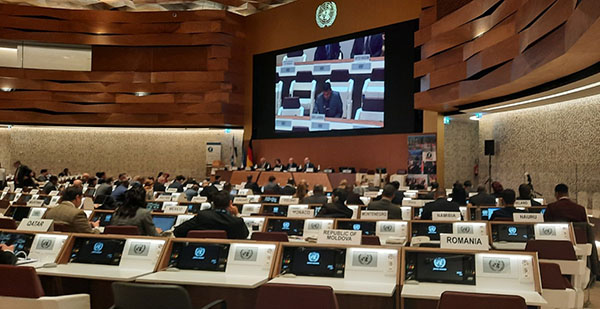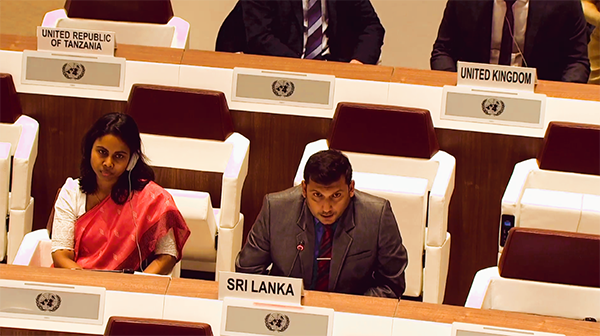Anti-Personnel Mine Ban Convention (APMBC), Twenty-First Meeting of State Parties, 20-24 November 2023, Statement by Sri Lanka-General Exchange of Views


Anti-Personnel Mine Ban Convention (APMBC),
Twenty-First Meeting of State Parties, 20-24 November 2023
Statement by Sri Lanka– General Exchange of Views
Delivered by Mr. Rajitha Ambalampitiya, Head of Operations and Senior Information Management System for Mine Action (IMSMA) officer of the National Mine Action Center (NMAC) of Sri Lanka on 20 November 2023
Thank you Mr. President,
First of all, allow me to express the Government of Sri Lanka’s sincere gratitude to the Implementation Support Unit (ISU) of the Convention and Geneva International Centre for Humanitarian Demining (GICHD) for your continuous support to Sri Lanka’s mine action programme.
We are pleased to inform you that Sri Lanka’s mine action programme has engaged in several important activities, in a collaborative manner with all international and national partners.
We are delighted to let you know that the National Mine Action Centre (NMAC) of Sri Lanka has started the Non-Technical Survey (NTS) to further clarify the remaining contamination problem. This allowed us to develop our national mine action strategy last year based on an updated contamination figure. Strategy is particularly important, given the critical stage of Sri Lanka’s mine action programme on its path to completion.
The identification and clearance of Explosive Ordnance (EO), including anti-personnel mined areas have been ongoing in Sri Lanka since 2002. The National Mine Action Centre and the Humanitarian Demining Units of Sri Lanka Army are working in close collaboration with national organisations Delvon Assistance for Social Harmony (DASH) and Skavita Humanitarian Assistance and Relief Project (SHARP) and international civil society partners HALO Trust and Mines Advisory Group (MAG) to identify and clear Explosive Ordnance (EO) in line with National Mine Action Standards, drawing on funding from the Government of Sri Lanka and several international donors.
Following accession to the Anti-Personnel Mine Ban Convention (APMBC) in December 2017, Sri Lanka has committed to identify and clear all AP mined areas by 1 June 2028, in line with its Article 5 obligations. Sri Lanka is confident that it will be able to fulfil this obligation by 2027. NMAC has predicted that total USD 75 million is required to achieve this target.
Sri Lanka experienced a major reduction in mine related accidents during the last ten years with only one mine related accident recorded in 2022. Sri Lanka recognizes that women, girls, boys and men may be affected differently by mine/Explosive Remnants of War (ERW) contamination due to their roles and responsibilities and might therefore have specific and varying needs and priorities.
As per the findings of the need assessment survey of mine and ERW victims, NMAC has provided immediate assistance in 2022 to the mine and ERW victims. However, NMAC has estimated USD 100,000 per year for the next three years to provide durable solution to uplift the lives of the Mine and ERW victims.
Residual mine/ERW contamination is a long-term issue, and Explosive Ordnance Risk Education (EORE) is a requirement for safe return and resettlement because demining does not guarantee land free of a residual hazard. EORE activities in Sri Lanka were drastically reduced since 2017 due to funding gaps, especially from the UNICEF. To fill the vacuum, the Government of Sri Lanka has set aside Rs 4 million to perform EORE activities in mine-affected areas: this amount is insufficient to cover all the affected districts.
Therefore, it is vital that EORE is continued in the mine affected areas. NMAC estimates that an annual investment of roughly USD100,000 will allow EORE organizations to keep casualty rates to a bare minimum. This is essential because contamination in mine-affected districts is still present in close proximity to a large number of population centres.
Since 2002, demining work has provided a solid livelihood for over 200,000 people, including women heads of households and persons with disabilities. As the country moves towards becoming mine-free in 2027, it is of vital importance to ensure that the livelihood of these people is supported and that the demining workforce can make the most of their experience and skills gained in the mine action sector through support provided to transition into mainstream economic sectors. NMAC has prepared a strategy for de-mobilising of de-mining workforce with the assistance of de-mining operators. NMAC has also started a NMAS review with the support of GICHD.
Mr. President
Government of Sri Lanka and its partners are very much looking forward to continue our collaboration with you all on Sri Lanka’s path towards complete mine clearance by 2027. Sri Lanka requests all partners to extend possible assistance in achieving this goal.
I thank you
